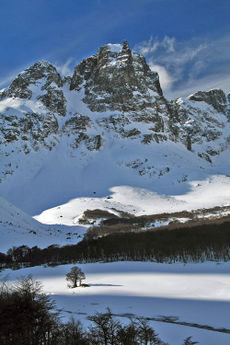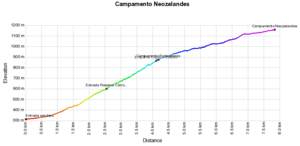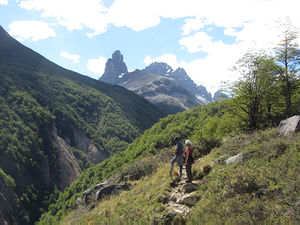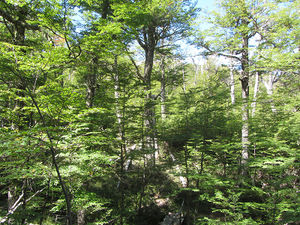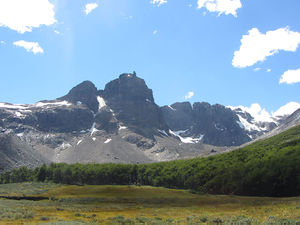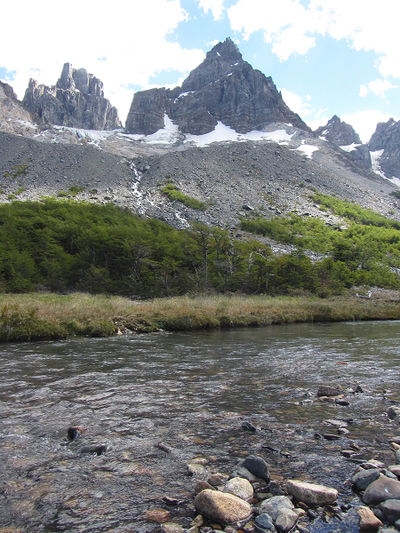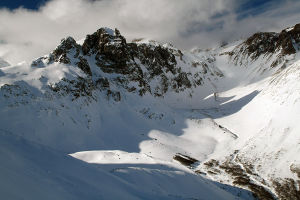Diferencia entre revisiones de «ENG:Neozelandes Camp, RN Cerro Castillo»
(→General Description) |
|||
| Línea 34: | Línea 34: | ||
The New Zealand Camp is also the base camp to ascend to all the mountains of the sector; Cerro Palo, Cerro Chocolate, Punta Duff and Cerro Castillo, among many others. | The New Zealand Camp is also the base camp to ascend to all the mountains of the sector; Cerro Palo, Cerro Chocolate, Punta Duff and Cerro Castillo, among many others. | ||
| − | == Appropriate time == | + | ==Appropriate time== |
All year. In the summer months, the trail is clearly marked in the forest, while in winter it is common for snow cover the forest from the Porters' Camp, being recommended only in case of having the necessary equipment and experience for these conditions. | All year. In the summer months, the trail is clearly marked in the forest, while in winter it is common for snow cover the forest from the Porters' Camp, being recommended only in case of having the necessary equipment and experience for these conditions. | ||
| Línea 41: | Línea 41: | ||
{{Acceso neozelandes}} | {{Acceso neozelandes}} | ||
| − | == Description of the | + | ==Description of the rout == |
| − | + | ===Day One: Big Horquetas (Laguna Chiguay) - Río Turbio Campsite=== | |
| + | [[File: Perfil_cerro_castillo.PNG | thumb | center | 750px | Profile of the Cerro Castillo trekking circuit. The red vertical lines separate the days]] | ||
| − | === Expected Time === | + | The ideal is to start this day early, since the trail is quite extensive. If you start from Laguna Chiguay, it adds up to another hour of walking, to take it into account. The starting point is very clear from the road, at a point that this makes a very pronounced inverted U and you see a deep valley to the west side of the road: there is a green sign of the "Chilean Trail". The corresponding gate must be crossed. |
| + | |||
| + | Following a path for 4 x 4 (the first day will almost always be along this path, which park rangers use in their vehicles), about 50 meters further on you have to cross a stream through a bridge of sticks about 20 meters above the track. The road runs along the left bank of the river, to be found after a few minutes with a CONAF booth where one can register, receive a map and pay the entrance to the park. It continues through spaces from which the forest for livestock has been cleared. In consideration of livestock, do not open the gates, since all were placed a small staircase on the right side, to allow the passage of walkers. | ||
| + | |||
| + | After that half hour, the trek goes through a clear path, passing through a house with stables to enter a forest surrounded by lengas for approximately one hour. At this point you go down towards small meadows with cattle, and you must walk straight until you find a stream. Beware of making mistakes, the correct path is found because you can see the gate on the other bank. To wade, it is best to take off your shoes and cross the river (recomandable carry a few shawls to cross, because the stones are slippery: eye with losing the chalas), which takes about 10 minutes, no more. The water reaches the knees, so it's not that difficult. From this point you should already be able to see Cerro Castillo and its glaciers. | ||
| + | |||
| + | After the gate, the road continues similarly as cattle pastures, without major difficulties. After an hour you must cross a new stream, in this case to be placed on the right side (north) of said water course, after another 45 minutes have to cross another stream. In total there are many streams in this path, which each time take a more ferrous color. Depending on the fluvial conditions of the time it is possible to cross them on the trunks or rocks arranged there, otherwise, you have to take off your shoes. | ||
| + | Later the road continues through a forest of lengas of great size, for after an hour see, below, a lagoon on the left. From this point, after about 30 to 45 minutes you will arrive at a campsite enabled by CONAF, with a cabin for the park ranger, tables, places to make fire and a latrine. The place is beautiful, since one is surrounded by lengas of about 15 to 20 meters high. If there are no more energies, one should stop here, but it's worth moving on to shorten the next day's walk. | ||
| + | |||
| + | After this CONAF campsite, you have to continue along the route until you reach Río Turbio, which is unmistakable due to the amount of material carried by the water. In the background, towards the south west is unmistakable the pass through which the next day will have to pass. One must continue along the riverbank to the left, guided by yellow metal signs, similar to a yielding step. At this point, one should see a sign carved in wood that indicates a campsite, however you have to continue about 10 minutes later to reach the place with tables and latrine. | ||
| + | |||
| + | The walk lasts about 6 to 7 hours from Las Horquetas. | ||
| + | |||
| + | ===Day Two: Río Turbio - Camping Estero del Bosque=== | ||
| + | |||
| + | This is the most intense day of trekking, and the only possible camping is at the end of the route, since you have to cross a pass. After the CONAF campsite, continue along the south side of the river, until the route begins to ascend through the lenga forest, becoming increasingly steep and consequently disappearing the forest. When crossing a small waterfall located in a clearing of the forest product of ancient landslides, a rest is good, because it really rises a lot. From now on there is no more forest and the river is crossed, already transformed into small water courses, to continue climbing by loose rocks, (follow the marks or the piles of stones) to arrive after about 90 to 120 minutes to the pass. . | ||
| + | |||
| + | ===Expected Time=== | ||
The ascent to the New Zealand Camp will take about 4.5 hours of walking including their respective breaks to enjoy the landscape. It is possible to make the excursion for the day from Cerro Castillo, however it is recommended to consider two days due to the demanding of the route, which has a total height of almost 1000 vertical meters. | The ascent to the New Zealand Camp will take about 4.5 hours of walking including their respective breaks to enjoy the landscape. It is possible to make the excursion for the day from Cerro Castillo, however it is recommended to consider two days due to the demanding of the route, which has a total height of almost 1000 vertical meters. | ||
| + | The pass is basically a passage between two mountains to the other side of the mountain range. The portezuelo is long, it is very boxed, it is very narrow and there is usually a lot of wind so you have to keep warm. From now on they are only stones, so the canes take a great importance. The wind can make rocks roll, so pay close attention to this. On both sides of the portezuelo, beautiful rocky figures are seen, incredibly vertical. From time to time it is good to look back to have a panoramic view of the Turbio River. Finally, when you reach the south mouth of the pass you can see the lagoon in the distance (on the right, like a calm celestial well), but one usually focuses on the El Peñón glacier and mountain on the right. Recommended to photograph and rest in this part. | ||
| + | |||
| + | From this point, the road drops abruptly (be careful with the falls), so in many sections you have to dare and invent a route to continue downhill until you reach the stream that starts as waterfalls from the hanging glacier. Eye that really under the stones there is glacier, not land, so it is easy for them to slip or have cracks. It follows along the south side of the stream a long stony stretch, until finally one ends up going into a dense forest of lengas, until literally the path ends, which is a sign of crossing the stream. There is a wooden bridge that facilitates this task. | ||
| + | |||
| + | Continue along the north bank, almost traveling west, to get to a place where you can take some pictures with the glacier and then sign with the camping sign that says "Camping Estero del Bosque", in the middle of a sector of large trees dead, with their trunks still standing as witnesses. You reach the west arm of the forest estuary (comes from the lagoon) and the route goes up its north bank, to arrive after about 25 minutes to Estero del Bosque campsite. From the pass to the campsite should be 2 1/2 to 3 hours (with detention time included to take pictures before the Glacier El Peñón). The total route should take about 6 hours, where the last ones are the most intense due to the descent and fatigue. | ||
| + | |||
| + | If you have started early, it is recommended to continue for about 1.5 hours to the La Tetera camp (2 km and 300 meters of altitude later), where you can rest with unbeatable views of El Peñón hill and glacier, as well as Cerro Castillo. You also earn time for the next day's route | ||
| + | . | ||
| + | ===Day Three: Camping Estero del Bosque - Laguna Cerro Castillo - Camp Porteadores=== | ||
| + | |||
| + | The proposed route proposes a quiet itinerary, going up to Cerro Castillo Lagoon and going down only half the way to camp at Campamento Porteadores. There is the possibility of, at that point, diverting an additional hour and a half up valley to visit the Estero valley stop, where the [[Neozelandes Camp, RN Cerro Castillo | New Zealand Camp]] is located, for which camping is recommended the second night at La Tetera campsite instead of at El Bosque. Another alternative for the strongest walkers is to continue descending to arrive, in a day, until Villa Cerro Castillo. | ||
| + | |||
| + | About 10 minutes after camping El Bosque you have to cross an arm of the estuary by a bridge. From this point the path continues up through the lenga forest for about 90 minutes until the forest begins to finish. Among these last remnants of the forest, is the campsite La Tetera, to camp on the upper side of the route, with Cerro Castillo very close, but does not offer basic services. La Laguna is about 15 minutes walk from this place, bordering the river that is born just from this same lagoon. There is an impressive view of the Glacier and Cerro Castillo. | ||
| + | |||
| + | The route continues on the south side of the lagoon rising steeply for about 1 hour, by rocks. Beware of this part, to avoid kinks and falls to reach a plain, where you can appreciate the beauty of the color of the lagoon and Cerro Castillo on it spilling its glacier. One SHOULD appear towards the south side (towards the opposite side to the lagoon) This plain is the very wide pass between two hills, from where one has a great panoramic of the northern sector of the General Carrera Lake, Villa Cerro Castillo, the southern highway , Ibañez River, (left) north ice fields and Hudson Volcano (right). It is worth to sit and contemplate and admire this view for its good minutes. In addition, in this sector there is cell signal (entel). | ||
| + | |||
| + | From here you can go down to Villa Cerro Castillo, by a path clearly marked by the left side facing the valley of the Ibáñez River and where there is much more traffic of people. The descent is not so long if a little steep, takes about 3 hours and a half, normal pace, to the town. | ||
| + | For the enthusiasts, you can go back and continue the ascent for about an hour in a west-northwest direction, to reach a new pass that in this case faces the valley of the Estero Parada. Supposedly, from this point there is a path that goes through the upper margin of the forest to reach the New Zealand Camp that saves the long descent to the Porters' Camp, however it is not an official trail the marks have been lost over the years. That is why it is recommended to go down following the red marks that correspond to the official trail. The descent is long, steep, loose and very exhausting. Once arrived at a small plot of land on the edge of the forest, the path becomes more easily recognized, continuing now not through the edge of the hill but directly towards the valley of the estuary. After about 45 minutes from the beginning of the forest, you will reach the path that goes up to the [[New Zealand Camp, RN Cerro Castillo | New Zealand Camp]]. To access the Porteadores camp you must turn to the right and after about 50 meters, on the other side of the stream, you will find the small shelter and a table of the Porters' Camp. Until this place they are around 4 hours of walk. | ||
| + | |||
| + | It is recommended to continue the trail up the valley stop to visit the [[Neozelandes Camp, RN Cerro Castillo | New Zealand Camp]], from where fantastic views of the valley of great mountains are obtained. They are about 1.5 additional hours until this camp walking through a beautiful Lengas forest. The detour is well worth it. | ||
| + | |||
| + | ===Day Four: Camp Porters - Villa Cerro Castillo=== | ||
| + | From Camp Porteadores you must continue down the valley following the path that is clearly marked. There are even some wooden benches strategically placed with the best views of the Parada River Valley and Cerro Palo. In about 45 minutes you reach the limit of the Reserve where you must cross the fence. A half hour later a gate is crossed, which must be left closed, then down a zig zag the last steep slope to the shore of the Estero Parada to finally continue through meadows that descend gently to the vehicular road. There are several tracks in these meadows, however you should always continue down to the south to find the path. When visualizing a large rock in the middle of the meadow, it is recommended to deviate a little to the right, towards the river, to be able to exit to the vehicular road on the bed of this one and avoid going through the houses. At this point there is a cellular signal to coordinate a transport from Villa Cerro Castillo, otherwise you must follow the 6.3 kilometers by vehicular road (about 90 to 120 minutes) until you reach Villa Cerro Castillo. | ||
| + | |||
| + | From Camp Porteadores are about three hours to Villa Cerro Castillo. They deserve a good meal, in the restaurant before arriving at the town, or in the post that is on the right of the road when arriving at the Villa, which is an old bus. In the town there are more options, such as complete, bread dough, and craft beer "Caiquén". | ||
[[File: Final_del_Valle_Parada.jpg | thumb | View of the end of the Estero Valley Stop above the New Zealand Camp from the top of Cerro Chocolate. Note that Laguna Duff is frozen and covered in snow.]] | [[File: Final_del_Valle_Parada.jpg | thumb | View of the end of the Estero Valley Stop above the New Zealand Camp from the top of Cerro Chocolate. Note that Laguna Duff is frozen and covered in snow.]] | ||
Revisión del 19:51 3 jun 2019
|
|
| |||||||||||||||||||||||||||||||||||||||||||||||
General Description
World famous is Cerro Cerro Castillo, clear star of the eyes of all visitors to the reserve of the same name. However, behind this colossus there is a valley that dazzles with great mountains of rock and fantastic landscapes. It is the valley of the estuary Parada, which, because it is usually at the end of the Trekking Cerro Castillo is overlooked by most of the walkers. However, this valley deserves the detour or even be the objective of an own excursion to enjoy this fantastic world of mountains.
The New Zealand Camp is also the base camp to ascend to all the mountains of the sector; Cerro Palo, Cerro Chocolate, Punta Duff and Cerro Castillo, among many others.
Appropriate time
All year. In the summer months, the trail is clearly marked in the forest, while in winter it is common for snow cover the forest from the Porters' Camp, being recommended only in case of having the necessary equipment and experience for these conditions.
Access
En vehículo propio
Salir de Coyhaique por la carretera Austral (ruta 7) hacia el sur. Tras una hora y media de viaje y después de cruzar el portezuelo Ibañez se alcanza el poblado de Villa Cerro Castillo, poblado con oferta de alojamiento, comida y tiendas de abarrotes. En la entrada al poblado, justo en frente al monumento al ovejero un camino vehicular de ripio en mal estado se interna hacia el oeste. Seguirlo 6,3 kilómetros hasta ver unos 200 metros mas adelante un estero que atraviesa el camino (Estero Parada). Hay espacio para estacionar el vehículo a un costado del camino.
En transporte público y autostop
Tomar alguna de las líneas de buses de Coyhaique a Cerro Castillo o una de las que pasando por este pueblo continúan hacia el sur. Desde Coyhaique salen varias líneas de buses en dirección al sur:
| Buses Sao Paulo | Coyhaique-Puerto Río Tranquilo-Cochrane (Ma, Ju y Sa, 8:00AM)
Cochrane-Rio Tranquilo-Coyhaique (Mi, Vi y Do) |
| Teléfonos +56672552143 / +56672255726 / +56998748022
Terminal Municipal Coyhaique (Lautaro esq. Magallanes) | |
| Águilas Patagónicas | Coyhaique-Puerto Río Tranquilo-Cochrane (Ma y Jue, 8:30AM)
Cochrane-Rio Tranquilo-Coyhaique (Lu, Mi y Vi) |
| Teléfonos +56672211288 / +56672216886
Terminal Municipal Coyhaique (Lautaro esq. Magallanes) | |
| Buses Don Carlos | Coyhaique-Puerto Río Tranquilo-Cochrane (Lu a Do, 9:30AM)
Cochrane-Rio Tranquilo-Coyhaique (Lu a Do) |
| Teléfonos +56672231981 / +56672232981
Sub. Teniente Cruz 63, Coyhaique | |
| Buses Acuario 13 | Coyhaique-Puerto Río Tranquilo-Cochrane (Ma a Do, 9:00AM)
Cochrane-Rio Tranquilo-Coyhaique (Lu y Mi a Do, 9:00AM) |
| Teléfonos +56672522143 / +56998748022
Terminal Municipal Coyhaique (Lautaro esq. Magallanes) | |
| Buses ECA | Coyhaique-Puerto Río Tranquilo (Ma y Vi, 13:00) |
| Teléfonos +56672431224 / +56672528577
Alejandro Gutiérrez 79, Coyhaique |
Valores aproximados: Coyhaique - Puerto Río Tranquilo: CLP$9000 (US$ 9.4 as of November 2024) / Coyhaique - Cochrane: CLP$13000 (US$ 13.5 as of November 2024) Desde el pueblo se deberá caminar por 6,3 kilómetro el camino vehicular hacia el oeste, que requiere algo menos de 2 horas de caminata. Desviarse a la derecha 200 metros antes de cruzar el Estero Parada.
Description of the rout
Day One: Big Horquetas (Laguna Chiguay) - Río Turbio Campsite
The ideal is to start this day early, since the trail is quite extensive. If you start from Laguna Chiguay, it adds up to another hour of walking, to take it into account. The starting point is very clear from the road, at a point that this makes a very pronounced inverted U and you see a deep valley to the west side of the road: there is a green sign of the "Chilean Trail". The corresponding gate must be crossed.
Following a path for 4 x 4 (the first day will almost always be along this path, which park rangers use in their vehicles), about 50 meters further on you have to cross a stream through a bridge of sticks about 20 meters above the track. The road runs along the left bank of the river, to be found after a few minutes with a CONAF booth where one can register, receive a map and pay the entrance to the park. It continues through spaces from which the forest for livestock has been cleared. In consideration of livestock, do not open the gates, since all were placed a small staircase on the right side, to allow the passage of walkers.
After that half hour, the trek goes through a clear path, passing through a house with stables to enter a forest surrounded by lengas for approximately one hour. At this point you go down towards small meadows with cattle, and you must walk straight until you find a stream. Beware of making mistakes, the correct path is found because you can see the gate on the other bank. To wade, it is best to take off your shoes and cross the river (recomandable carry a few shawls to cross, because the stones are slippery: eye with losing the chalas), which takes about 10 minutes, no more. The water reaches the knees, so it's not that difficult. From this point you should already be able to see Cerro Castillo and its glaciers.
After the gate, the road continues similarly as cattle pastures, without major difficulties. After an hour you must cross a new stream, in this case to be placed on the right side (north) of said water course, after another 45 minutes have to cross another stream. In total there are many streams in this path, which each time take a more ferrous color. Depending on the fluvial conditions of the time it is possible to cross them on the trunks or rocks arranged there, otherwise, you have to take off your shoes. Later the road continues through a forest of lengas of great size, for after an hour see, below, a lagoon on the left. From this point, after about 30 to 45 minutes you will arrive at a campsite enabled by CONAF, with a cabin for the park ranger, tables, places to make fire and a latrine. The place is beautiful, since one is surrounded by lengas of about 15 to 20 meters high. If there are no more energies, one should stop here, but it's worth moving on to shorten the next day's walk.
After this CONAF campsite, you have to continue along the route until you reach Río Turbio, which is unmistakable due to the amount of material carried by the water. In the background, towards the south west is unmistakable the pass through which the next day will have to pass. One must continue along the riverbank to the left, guided by yellow metal signs, similar to a yielding step. At this point, one should see a sign carved in wood that indicates a campsite, however you have to continue about 10 minutes later to reach the place with tables and latrine.
The walk lasts about 6 to 7 hours from Las Horquetas.
Day Two: Río Turbio - Camping Estero del Bosque
This is the most intense day of trekking, and the only possible camping is at the end of the route, since you have to cross a pass. After the CONAF campsite, continue along the south side of the river, until the route begins to ascend through the lenga forest, becoming increasingly steep and consequently disappearing the forest. When crossing a small waterfall located in a clearing of the forest product of ancient landslides, a rest is good, because it really rises a lot. From now on there is no more forest and the river is crossed, already transformed into small water courses, to continue climbing by loose rocks, (follow the marks or the piles of stones) to arrive after about 90 to 120 minutes to the pass. .
Expected Time
The ascent to the New Zealand Camp will take about 4.5 hours of walking including their respective breaks to enjoy the landscape. It is possible to make the excursion for the day from Cerro Castillo, however it is recommended to consider two days due to the demanding of the route, which has a total height of almost 1000 vertical meters. The pass is basically a passage between two mountains to the other side of the mountain range. The portezuelo is long, it is very boxed, it is very narrow and there is usually a lot of wind so you have to keep warm. From now on they are only stones, so the canes take a great importance. The wind can make rocks roll, so pay close attention to this. On both sides of the portezuelo, beautiful rocky figures are seen, incredibly vertical. From time to time it is good to look back to have a panoramic view of the Turbio River. Finally, when you reach the south mouth of the pass you can see the lagoon in the distance (on the right, like a calm celestial well), but one usually focuses on the El Peñón glacier and mountain on the right. Recommended to photograph and rest in this part.
From this point, the road drops abruptly (be careful with the falls), so in many sections you have to dare and invent a route to continue downhill until you reach the stream that starts as waterfalls from the hanging glacier. Eye that really under the stones there is glacier, not land, so it is easy for them to slip or have cracks. It follows along the south side of the stream a long stony stretch, until finally one ends up going into a dense forest of lengas, until literally the path ends, which is a sign of crossing the stream. There is a wooden bridge that facilitates this task.
Continue along the north bank, almost traveling west, to get to a place where you can take some pictures with the glacier and then sign with the camping sign that says "Camping Estero del Bosque", in the middle of a sector of large trees dead, with their trunks still standing as witnesses. You reach the west arm of the forest estuary (comes from the lagoon) and the route goes up its north bank, to arrive after about 25 minutes to Estero del Bosque campsite. From the pass to the campsite should be 2 1/2 to 3 hours (with detention time included to take pictures before the Glacier El Peñón). The total route should take about 6 hours, where the last ones are the most intense due to the descent and fatigue.
If you have started early, it is recommended to continue for about 1.5 hours to the La Tetera camp (2 km and 300 meters of altitude later), where you can rest with unbeatable views of El Peñón hill and glacier, as well as Cerro Castillo. You also earn time for the next day's route .
Day Three: Camping Estero del Bosque - Laguna Cerro Castillo - Camp Porteadores
The proposed route proposes a quiet itinerary, going up to Cerro Castillo Lagoon and going down only half the way to camp at Campamento Porteadores. There is the possibility of, at that point, diverting an additional hour and a half up valley to visit the Estero valley stop, where the New Zealand Camp is located, for which camping is recommended the second night at La Tetera campsite instead of at El Bosque. Another alternative for the strongest walkers is to continue descending to arrive, in a day, until Villa Cerro Castillo.
About 10 minutes after camping El Bosque you have to cross an arm of the estuary by a bridge. From this point the path continues up through the lenga forest for about 90 minutes until the forest begins to finish. Among these last remnants of the forest, is the campsite La Tetera, to camp on the upper side of the route, with Cerro Castillo very close, but does not offer basic services. La Laguna is about 15 minutes walk from this place, bordering the river that is born just from this same lagoon. There is an impressive view of the Glacier and Cerro Castillo.
The route continues on the south side of the lagoon rising steeply for about 1 hour, by rocks. Beware of this part, to avoid kinks and falls to reach a plain, where you can appreciate the beauty of the color of the lagoon and Cerro Castillo on it spilling its glacier. One SHOULD appear towards the south side (towards the opposite side to the lagoon) This plain is the very wide pass between two hills, from where one has a great panoramic of the northern sector of the General Carrera Lake, Villa Cerro Castillo, the southern highway , Ibañez River, (left) north ice fields and Hudson Volcano (right). It is worth to sit and contemplate and admire this view for its good minutes. In addition, in this sector there is cell signal (entel).
From here you can go down to Villa Cerro Castillo, by a path clearly marked by the left side facing the valley of the Ibáñez River and where there is much more traffic of people. The descent is not so long if a little steep, takes about 3 hours and a half, normal pace, to the town. For the enthusiasts, you can go back and continue the ascent for about an hour in a west-northwest direction, to reach a new pass that in this case faces the valley of the Estero Parada. Supposedly, from this point there is a path that goes through the upper margin of the forest to reach the New Zealand Camp that saves the long descent to the Porters' Camp, however it is not an official trail the marks have been lost over the years. That is why it is recommended to go down following the red marks that correspond to the official trail. The descent is long, steep, loose and very exhausting. Once arrived at a small plot of land on the edge of the forest, the path becomes more easily recognized, continuing now not through the edge of the hill but directly towards the valley of the estuary. After about 45 minutes from the beginning of the forest, you will reach the path that goes up to the New Zealand Camp. To access the Porteadores camp you must turn to the right and after about 50 meters, on the other side of the stream, you will find the small shelter and a table of the Porters' Camp. Until this place they are around 4 hours of walk.
It is recommended to continue the trail up the valley stop to visit the New Zealand Camp, from where fantastic views of the valley of great mountains are obtained. They are about 1.5 additional hours until this camp walking through a beautiful Lengas forest. The detour is well worth it.
Day Four: Camp Porters - Villa Cerro Castillo
From Camp Porteadores you must continue down the valley following the path that is clearly marked. There are even some wooden benches strategically placed with the best views of the Parada River Valley and Cerro Palo. In about 45 minutes you reach the limit of the Reserve where you must cross the fence. A half hour later a gate is crossed, which must be left closed, then down a zig zag the last steep slope to the shore of the Estero Parada to finally continue through meadows that descend gently to the vehicular road. There are several tracks in these meadows, however you should always continue down to the south to find the path. When visualizing a large rock in the middle of the meadow, it is recommended to deviate a little to the right, towards the river, to be able to exit to the vehicular road on the bed of this one and avoid going through the houses. At this point there is a cellular signal to coordinate a transport from Villa Cerro Castillo, otherwise you must follow the 6.3 kilometers by vehicular road (about 90 to 120 minutes) until you reach Villa Cerro Castillo.
From Camp Porteadores are about three hours to Villa Cerro Castillo. They deserve a good meal, in the restaurant before arriving at the town, or in the post that is on the right of the road when arriving at the Villa, which is an old bus. In the town there are more options, such as complete, bread dough, and craft beer "Caiquén".
Permits / Rates
Although the Estero Parada valley is part of the Cerro Castillo National Reserve, there is no control of CONAF in access to this trail. However, it is recommended to record the visit and pay the entrance to the park administration located on the road Coyhaique - Villa Cerro Castillo after the Chiguay lagoon. In the New Zealand Camp it is likely to find CONAF park rangers.
Tarifas a enero de 2019:
- Circuito Las Horquetas: CLP$23500 (US$ 24.5 as of November 2024)
- Acceso directo a laguna: CLP$10000 (US$ 10.4 as of November 2024)
- Campamento Neozelandés: $10.000. Nota: Para acceder a este valor se debe indicar en la entrada en Estero Parada que se irá al Campamento Neozelandés a hacer actividades de montaña y rellenar la ficha correspondiente.
Hire Guides
- Expediciones GeoSur, Coyhaique, teléfono: +56672211677 , celular: +56992648671, info@geosurexpediciones.com, página web Expediciones GeoSur.
- Jorge Aguilar Chacano, Villa Cerro Castillo, celular: +56992609525, cumbreyglaciares@yahoo.es.
Recommendations
- Checklist: Aunque sepas perfectamente lo que debes llevar, es preferible chequearlo al empacar. Esta ruta ha sido clasificada como Checklist de equipo tipo 4: ruta de baja altitud, sin nieve ni frío, con acampe.
- Take your trash and whatever you find. No one else will do it for you.
- Avoid making fire. If necessary, extreme precautions due to strong winds and abundant plant matter. These forests have still been saved from fires. Do not be the one to burn them!
Photo Gallery
The needles of Cerro Castillo seen from the New Zealander Camp in August of 2017. Photo: Tobias Hellwig



